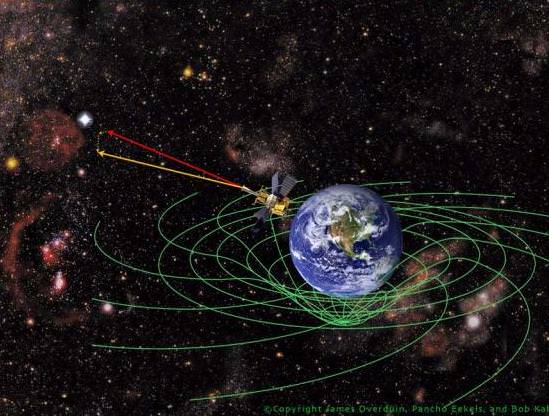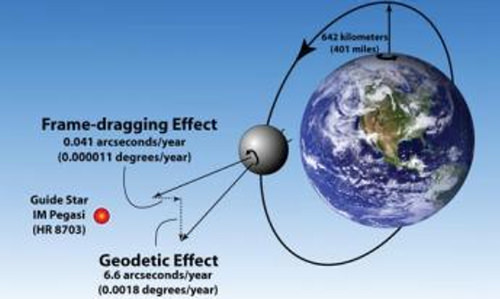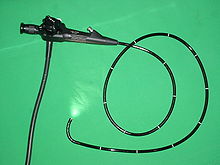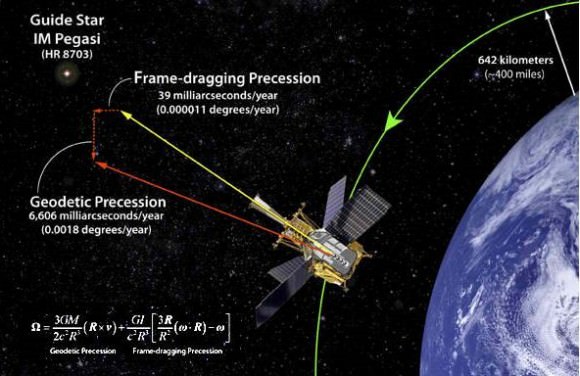Universe Today | Steve Nerlich | 2011 Jan 29
<-- PreviousThere’s a line out of an early episode of The Big Bang Theory series, where Gravity Probe B is described as having seen ‘glimpses’ of Einstein’s predicted frame-dragging effect. In reality, it is not entirely clear that the experiment was able to definitively distinguish a frame-dragging effect from a background noise created by some exceedingly minor aberrations in its detection system.
Whether or not this counts as a glimpse – frame-dragging (the alleged last untested prediction of general relativity) and Gravity Probe B have become linked in the public consciousness. So here’s a quick primer on what Gravity Probe B may or may not have glimpsed.
The Gravity Probe B satellite was launched in 2004 and set into a 650 kilometer altitude polar orbit around the Earth with four spherical gyroscopes spinning within it. The experimental design proposed that in the absence of space-time curvature or frame-dragging, these gyroscopes moving in a free fall orbit should spin with their axis of rotation unerringly aligned with a distant reference point (in this case, the star IM Pegasi).
To avoid any electromagnetic interference from the Earth’s magnetic field, the gyroscopes were housed within a lead-lined thermos flask – the shell of which was filled with liquid helium. This shielded the instruments from external magnetic interference and the cold enabled superconductance within the detectors designed to monitor the gyroscopes’ spin.
Slowly leaking helium from the flask was also used as a propellant. To ensure the gyroscopes remained in free fall in the event that the satellite encountered any atmospheric drag – the satellite could make minute trajectory adjustments, essentially flying itself around the gyroscopes to ensure they never came in to contact with the sides of their containers.
Now, although the gyroscopes were in free fall – it was a free fall going around and around a space-time warping planet. A gyroscope moving at a constant velocity in fairly empty space is also in a ‘weightless’ free fall – and such a gyroscope could be expected to spin indefinitely about its axis, without that axis ever shifting. Similarly, under Newton’s interpretation of gravity – being a force acting at a distance between massive objects – there is no reason why the spin axis of a gyroscope in a free fall orbit should shift either.
But for a gyroscope moving in Einstein’s interpretation of a steeply curved space-time surrounding a planet, its spin axis should ‘lean over’ into the slope of space-time. So over one full orbit of the Earth, the spin axis will end up pointing in a slightly different direction than the direction it started from – see the animation at the end of this clip. This is called the geodetic effect – and Gravity Probe B did effectively demonstrate this effect’s existence to within only a 0.5% likelihood that the data was showing a null effect.
But, not only is Earth a massive space-time curving object, it also rotates. This rotation should, theoretically, create a drag on the space-time that the Earth is embedded within. So, this frame-dragging should tug something that’s in orbit forward in the direction of the Earth’s rotation.
Where the geodetic effect shifts a polar-orbiting gyroscope’s spin axis in a latitudinal direction – frame-dragging (also known as the Lense-Thirring effect), should shift it in a longitudinal direction.
And here is where Gravity Probe B didn’t quite deliver. The geodetic effect was found to shift the gyroscopes spin axis by 6,606 milliarcseconds per year, while the frame-dragging effect was expected to shift it by 41 milliarcseconds per year. This much smaller effect has been difficult to distinguish from a background noise arising from minute imperfections existing within the gyroscopes themselves. Two key problems were apparently a changing polhode path and larger than expected manifestation of a Newtonian gyro torque – or let’s just say that despite best efforts, the gyroscopes still wobbled a bit.
There is ongoing work to laboriously extract the expected data of interest from the noisy data record, via a number of assumptions which might yet be subject to further debate. A 2009 report boldly claimed that the frame-dragging effect is now plainly visible in the processed data – although the likelihood that the data represents a null effect is elsewhere reported at 15%. So maybe glimpsed is a better description for now.
Incidentally, Gravity Probe A was launched back in 1976 – and in a two hour orbit effectively confirmed Einstein’s redshift prediction to within 1.4 parts in 10,000. Or let’s just say that it showed that a clock at 10,000 km altitude was found to run significantly faster than a clock on the ground.
Further reading:





